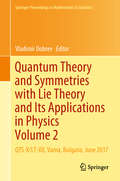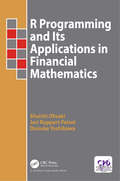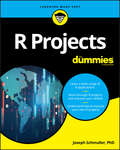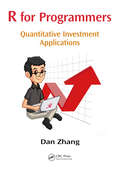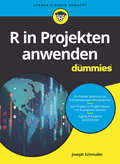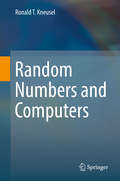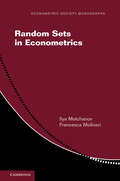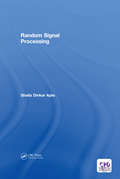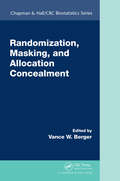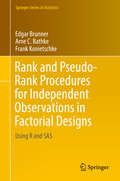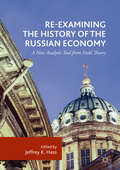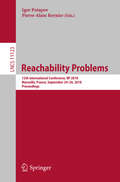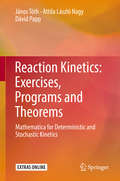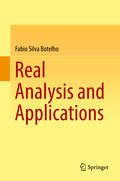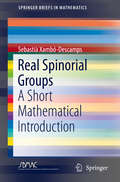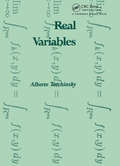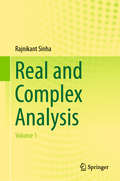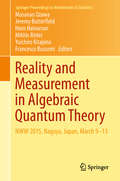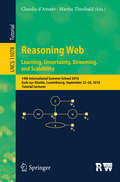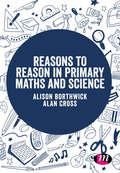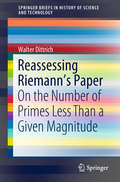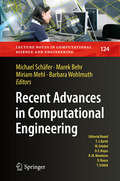- Table View
- List View
Quantum Theory and Symmetries with Lie Theory and Its Applications in Physics Volume 2: QTS-X/LT-XII, Varna, Bulgaria, June 2017 (Springer Proceedings in Mathematics & Statistics #255)
by Vladimir DobrevThis book is the second volume of the proceedings of the joint conference X. International Symposium “Quantum Theory and Symmetries” (QTS-X) and XII. International Workshop “Lie Theory and Its Applications in Physics” (LT-XII), 19–25 June 2017, Varna, Bulgaria.The QTS series started around the core concept that symmetries underlie all descriptions of quantum systems. It has since evolved into a symposium on the frontiers of theoretical and mathematical physics. The LT series covers the whole field of Lie Theory in its widest sense together with its applications in many facets of physics. As an interface between mathematics and physics the workshop serves as a meeting place for mathematicians and theoretical and mathematical physicists.In the division of the material between the two volumes, the Editor has tried to select for the first and second volumes papers that are more oriented toward mathematics and physics, respectively. However, this division is relative since many papers could have been placed in either volume. The topics covered in this volume represent the most modern trends in the fields of the joint conferences: symmetries in string theories, conformal field theory, holography, gravity theories and cosmology, gauge theories, foundations of quantum theory, nonrelativistic and classical theories.
R Programming and Its Applications in Financial Mathematics
by Shuichi Ohsaki Jori Ruppert-Felsot Daisuke YoshikawaThis book provides an introduction to R programming and a summary of financial mathematics. <P><P>It is not always easy for graduate students to grasp an overview of the theory of finance in an abstract form. For newcomers to the finance industry, it is not always obvious how to apply the abstract theory to the real financial data they encounter. Introducing finance theory alongside numerical applications makes it easier to grasp the subject. <P><P>Popular programming languages like C++, which are used in many financial applications are meant for general-purpose requirements. They are good for implementing large-scale distributed systems for simultaneously valuing many financial contracts, but they are not as suitable for small-scale ad-hoc analysis or exploration of financial data. The R programming language overcomes this problem. R can be used for numerical applications including statistical analysis, time series analysis, numerical methods for pricing financial contracts, etc. <P><P>This book provides an overview of financial mathematics with numerous examples numerically illustrated using the R programming language.
R Projects For Dummies
by Joseph SchmullerMake the most of R’s extensive toolset R Projects For Dummies offers a unique learn-by-doing approach. You will increase the depth and breadth of your R skillset by completing a wide variety of projects. By using R’s graphics, interactive, and machine learning tools, you’ll learn to apply R’s extensive capabilities in an array of scenarios. The depth of the project experience is unmatched by any other content online or in print. And you just might increase your statistics knowledge along the way, too! R is a free tool, and it’s the basis of a huge amount of work in data science. It's taking the place of costly statistical software that sometimes takes a long time to learn. One reason is that you can use just a few R commands to create sophisticated analyses. Another is that easy-to-learn R graphics enable you make the results of those analyses available to a wide audience. This book will help you sharpen your skills by applying them in the context of projects with R, including dashboards, image processing, data reduction, mapping, and more. Appropriate for R users at all levels Helps R programmers plan and complete their own projects Focuses on R functions and packages Shows how to carry out complex analyses by just entering a few commands If you’re brand new to R or just want to brush up on your skills, R Projects For Dummies will help you complete your projects with ease.
R for Programmers: Quantitative Investment Applications
by Dan ZhangAfter the fundamental volume and the advanced technique volume, this volume focuses on R applications in the quantitative investment area. Quantitative investment has been hot for some years, and there are more and more startups working on it, combined with many other internet communities and business models. R is widely used in this area, and can be a very powerful tool. The author introduces R applications with cases from his own startup, covering topics like portfolio optimization and risk management.
R in Projekten anwenden für Dummies (Für Dummies)
by Joseph SchmullerDieses Buch bietet einen einzigartigen Learning-by-Doing-Ansatz. Sie werden Ihre R-Fähigkeiten erweitern und vertiefen, indem Sie eine Vielzahl von Beispielprojekten aus der Praxis nachvollziehen. Erlernen Sie die Grundlagen von R und RStudio sowie Möglichkeiten der Datenreduktion, des Mapping und der Bildverarbeitung. Dabei kommen Werkzeuge zum Einsatz, die Daten grafisch auswerten, die Analyse interaktiv machen oder die maschinelles Lernen einsetzen. Und auf dem Weg dahin können Sie sogar Ihr Statistikwissen noch erweitern. Warum sollten Sie das Rad neu erfinden, wenn es schon fertige R-Pakete gibt, die Ihre Bedürfnisse bedienen? Hier lernen Sie sie kennen.
Random Numbers and Computers
by Ronald T. KneuselThis book covers pseudorandom number generation algorithms, evaluation techniques, and offers practical advice and code examples. Random Numbers and Computers is an essential introduction or refresher on pseudorandom numbers in computer science. The first comprehensive book on the topic, readers are provided with a practical introduction to the techniques of pseudorandom number generation, including how the algorithms work and how to test the output to decide if it is suitable for a particular purpose. Practical applications are demonstrated with hands-on presentation and descriptions that readers can apply directly to their own work. Examples are in C and Python and given with an emphasis on understanding the algorithms to the point of practical application. The examples are meant to be implemented, experimented with and improved/adapted by the reader.
Random Sets in Econometrics (Econometric Society Monographs #60)
by Ilya Molchanov Francesca MolinariRandom set theory is a fascinating branch of mathematics that amalgamates techniques from topology, convex geometry, and probability theory. Social scientists routinely conduct empirical work with data and modelling assumptions that reveal a set to which the parameter of interest belongs, but not its exact value. Random set theory provides a coherent mathematical framework to conduct identification analysis and statistical inference in this setting and has become a fundamental tool in econometrics and finance. <P>This is the first book dedicated to the use of the theory in econometrics, written to be accessible for readers without a background in pure mathematics. Molchanov and Molinari define the basics of the theory and illustrate the mathematical concepts by their application in the analysis of econometric models. The book includes sets of exercises to accompany each chapter as well as examples to help readers apply the theory effectively.<P>Remains accessible for the average reader without advanced knowledge in mathematics.<P> Includes examples of applications to some important problems in econometrics, offering a blue-print for how to apply the techniques in different models.<P> Provides sets of exercises to accompany each chapter.
Random Signal Processing
by Shaila Dinkar ApteThis book covers random signals and random processes along with estimation of probability density function, estimation of energy spectral density and power spectral density. The properties of random processes and signal modelling are discussed with basic communication theory estimation and detection. MATLAB simulations are included for each concept with output of the program with case studies and project ideas. The chapters progressively introduce and explain the concepts of random signals and cover multiple applications for signal processing. The book is designed to cater to a wide audience starting from the undergraduates (electronics, electrical, instrumentation, computer, and telecommunication engineering) to the researchers working in the pertinent fields. <P><P> Key Features: <li>Aimed at random signal processing with parametric signal processing-using appropriate segment size. <li>Covers speech, image, medical images, EEG and ECG signal processing. <li> Reviews optimal detection and estimation. <li>Discusses parametric modeling and signal processing in transform domain. <li>Includes MATLAB codes and relevant exercises, case studies and solved examples including multiple choice questions
Randomization, Masking, and Allocation Concealment (Chapman & Hall/CRC Biostatistics Series)
by Vance BergerRandomization, Masking, and Allocation Concealment is indispensable for any trial researcher who wants to use state of the art randomization methods, and also wants to be able to describe these methods correctly. <P><P>Far too often the subtle nuances that distinguish proper randomization from flawed randomization are completely ignored in trial reports that state only that randomization was used, with no additional information. Experience has shown that in many cases, the type of randomization that was used was flawed. It is only a matter of time before medical journals and regulatory agencies come to realize that we can no longer rely on (or publish) flawed trials, and that flawed randomization in and of itself disqualifies a trial from being robust or high quality, even if that trial is of high quality otherwise. <P><P>This book will help to clarify the role randomization plays in ensuring internal validity, and in drawing valid inferences from the data. The various chapters cover a variety of randomization methods, and are not limited to the most common (and most flawed) ones. Readers will come away with a profound understanding of what constitutes a valid randomization procedure, so that they can distinguish the valid from the flawed among not only existing methods but also methods yet to be developed.
Rank and Pseudo-Rank Procedures for Independent Observations in Factorial Designs: Using R and SAS (Springer Series in Statistics)
by Edgar Brunner Arne C. Bathke Frank KonietschkeThis book explains how to analyze independent data from factorial designs without having to make restrictive assumptions, such as normality of the data, or equal variances. The general approach also allows for ordinal and even dichotomous data. The underlying effect size is the nonparametric relative effect, which has a simple and intuitive probability interpretation. The data analysis is presented as comprehensively as possible, including appropriate descriptive statistics which follow a nonparametric paradigm, as well as corresponding inferential methods using hypothesis tests and confidence intervals based on pseudo-ranks. Offering clear explanations, an overview of the modern rank- and pseudo-rank-based inference methodology and numerous illustrations with real data examples, as well as the necessary R/SAS code to run the statistical analyses, this book is a valuable resource for statisticians and practitioners alike.
Re-Examining the History of the Russian Economy: A New Analytic Tool from Field Theory
by Jeffrey K. HassThis book explores the application of field theory (patterns of interaction) to Russian economic history, and how social and political fields mediate the influences of institutions, structures, discourses and ideologies in the creation and dissemination of economic thinking, theory and practice. Using focused cases on Russia's economy from the mid-nineteenth century to the present, Hass and co-authors expand the empirical basis of field studies to provide new material on Russian economic history. The cases are divided into two complementary halves: i) The role of fields of institutions, discourses, and structures in the development of Russian economic thought, especially economic theories and discourses; and ii) The role of fields in the real adoption and implementation of policies in Soviet and Russian economic history. With developed discussion of fields and field theory, this book moves beyond sociology to demonstrate to other disciplines the relation of fields and field theory to other frameworks and methodological considerations for field analysis, as well as providing new empirical insights and narratives not as well-known abroad.
Reachability Problems: 12th International Conference, RP 2018, Marseille, France, September 24-26, 2018, Proceedings (Lecture Notes in Computer Science #11123)
by Igor Potapov Pierre-Alain ReynierThis book constitutes the refereed proceedings of the 12th International Conference on Reachability Problems, RP 2018, held in Marseille, France, in September 2018.The 11 full papers presented were carefully reviewed and selected from 21 submissions. The papers cover topics such as reachability for infinite state systems; rewriting systems; reachability analysis in counter/timed/cellular/communicating automata; Petri nets; computational aspects of semigroups, groups, and rings; reachability in dynamical and hybrid systems; frontiers between decidable and undecidable reachability problems; complexity and decidability aspects; predictability in iterative maps, and new computational paradigms.
Reaction Kinetics: Mathematica for Deterministic and Stochastic Kinetics
by János Tóth Attila László Nagy Dávid PappFifty years ago, a new approach to reaction kinetics began to emerge: one based on mathematical models of reaction kinetics, or formal reaction kinetics. Since then, there has been a rapid and accelerated development in both deterministic and stochastic kinetics, primarily because mathematicians studying differential equations and algebraic geometry have taken an interest in the nonlinear differential equations of kinetics, which are relatively simple, yet capable of depicting complex behavior such as oscillation, chaos, and pattern formation. The development of stochastic models was triggered by the fact that novel methods made it possible to measure molecules individually. Now it is high time to make the results of the last half-century available to a larger audience: students of chemistry, chemical engineering and biochemistry, not to mention applied mathematics. Based on recent papers, this book presents the most important concepts and results, together with a wealth of solved exercises. The book is accompanied by the authors’ Mathematica package, ReactionKinetics, which helps both students and scholars in their everyday work, and which can be downloaded from http://extras.springer.com/ and also from the authors’ websites. Further, the large set of unsolved problems provided may serve as a springboard for individual research.
Ready New York COS 8 Mathematics Instruction
by Cynthia TrippReady® New York COS 8 Mathematics Instruction
Real Analysis and Applications
by Fabio Silva BotelhoThis textbook introduces readers to real analysis in one and n dimensions. It is divided into two parts: Part I explores real analysis in one variable, starting with key concepts such as the construction of the real number system, metric spaces, and real sequences and series. In turn, Part II addresses the multi-variable aspects of real analysis. Further, the book presents detailed, rigorous proofs of the implicit theorem for the vectorial case by applying the Banach fixed-point theorem and the differential forms concept to surfaces in Rn. It also provides a brief introduction to Riemannian geometry. With its rigorous, elegant proofs, this self-contained work is easy to read, making it suitable for undergraduate and beginning graduate students seeking a deeper understanding of real analysis and applications, and for all those looking for a well-founded, detailed approach to real analysis.
Real Spinorial Groups: A Short Mathematical Introduction (SpringerBriefs in Mathematics)
by Sebastià Xambó-DescampsThis book explores the Lipschitz spinorial groups (versor, pinor, spinor and rotor groups) of a real non-degenerate orthogonal geometry (or orthogonal geometry, for short) and how they relate to the group of isometries of that geometry.After a concise mathematical introduction, it offers an axiomatic presentation of the geometric algebra of an orthogonal geometry. Once it has established the language of geometric algebra (linear grading of the algebra; geometric, exterior and interior products; involutions), it defines the spinorial groups, demonstrates their relation to the isometry groups, and illustrates their suppleness (geometric covariance) with a variety of examples. Lastly, the book provides pointers to major applications, an extensive bibliography and an alphabetic index.Combining the characteristics of a self-contained research monograph and a state-of-the-art survey, this book is a valuable foundation reference resource on applications for both undergraduate and graduate students.
Real Variables (Pure And Applied Mathematics Ser. #Volume 123)
by Alberto TorchinskyA modern introduction to the theory of real variables and its applications to all areas of analysis and partial differential equations. The book discusses the foundations of analysis, including the theory of integration, the Lebesque and abstract integrals, the Radon-Nikodym Theorem, the Theory of Banach and Hilbert spaces, and a glimpse of Fourier series. All material is presented in a clear and motivational fashion.
Real and Complex Analysis: Volume 2
by Rajnikant SinhaThis is the first volume of the two-volume book on real and complex analysis. This volume is an introduction to measure theory and Lebesgue measure where the Riesz representation theorem is used to construct Lebesgue measure. Intended for undergraduate students of mathematics and engineering, it covers the essential analysis that is needed for the study of functional analysis, developing the concepts rigorously with sufficient detail and with minimum prior knowledge of the fundamentals of advanced calculus required. Divided into three chapters, it discusses exponential and measurable functions, Riesz representation theorem, Borel and Lebesgue measure, -spaces, Riesz–Fischer theorem, Vitali–Caratheodory theorem, the Fubini theorem, and Fourier transforms. Further, it includes extensive exercises and their solutions with each concept. The book examines several useful theorems in the realm of real and complex analysis, most of which are the work of great mathematicians of the 19th and 20th centuries.
Real and Complex Analysis: Volume 2
by Rajnikant SinhaThis is the second volume of the two-volume book on real and complex analysis. This volume is an introduction to the theory of holomorphic functions. Multivalued functions and branches have been dealt carefully with the application of the machinery of complex measures and power series. Intended for undergraduate students of mathematics and engineering, it covers the essential analysis that is needed for the study of functional analysis, developing the concepts rigorously with sufficient detail and with minimum prior knowledge of the fundamentals of advanced calculus required. Divided into four chapters, it discusses holomorphic functions and harmonic functions, Schwarz reflection principle, infinite product and the Riemann mapping theorem, analytic continuation, monodromy theorem, prime number theorem, and Picard’s little theorem. Further, it includes extensive exercises and their solutions with each concept. The book examines several useful theorems in the realm of real and complex analysis, most of which are the work of great mathematicians of the 19th and 20th centuries.
Reality and Measurement in Algebraic Quantum Theory: Nagoya, Japan, March 9-13 2015 (Springer Proceedings in Mathematics & Statistics #261)
by Miklós Rédei Francesco Buscemi Jeremy Butterfield Masanao Ozawa Hans Halvorson Yuichiro KitajimaThis volume contains papers based on presentations at the “Nagoya Winter Workshop 2015: Reality and Measurement in Algebraic Quantum Theory (NWW 2015)”, held in Nagoya, Japan, in March 2015. The foundations of quantum theory have been a source of mysteries, puzzles, and confusions, and have encouraged innovations in mathematical languages to describe, analyze, and delineate this wonderland. Both ontological and epistemological questions about quantum reality and measurement have been placed in the center of the mysteries explored originally by Bohr, Heisenberg, Einstein, and Schrödinger. This volume describes how those traditional problems are nowadays explored from the most advanced perspectives. It includes new research results in quantum information theory, quantum measurement theory, information thermodynamics, operator algebraic and category theoretical foundations of quantum theory, and the interplay between experimental and theoretical investigations on the uncertainty principle. This book is suitable for a broad audience of mathematicians, theoretical and experimental physicists, and philosophers of science.
Reasoning Web. Learning, Uncertainty, Streaming, and Scalability: 14th International Summer School 2018, Esch-sur-Alzette, Luxembourg, September 22–26, 2018, Tutorial Lectures (Lecture Notes in Computer Science #11078)
by Claudia D’Amato Martin TheobaldThis volume contains lecture notes of the 14th Reasoning Web Summer School (RW 2018), held in Esch-sur-Alzette, Luxembourg, in September 2018. The research areas of Semantic Web, Linked Data, and Knowledge Graphs have recently received a lot of attention in academia and industry. Since its inception in 2001, the Semantic Web has aimed at enriching the existing Web with meta-data and processing methods, so as to provide Web-based systems with intelligent capabilities such as context awareness and decision support. The Semantic Web vision has been driving many community efforts which have invested a lot of resources in developing vocabularies and ontologies for annotating their resources semantically. Besides ontologies, rules have long been a central part of the Semantic Web framework and are available as one of its fundamental representation tools, with logic serving as a unifying foundation. Linked Data is a related research area which studies how one can make RDF data available on the Web and interconnect it with other data with the aim of increasing its value for everybody. Knowledge Graphs have been shown useful not only for Web search (as demonstrated by Google, Bing, etc.) but also in many application domains.
Reasons to Reason in Primary Maths and Science
by Alan Cross Alison BorthwickHow can teachers help children to develop reasoning skills? What is reasoning and how do we teach it? Much is being said in schools and education about the importance of reasoning skills. This book explores what reasoning is and what it is not. It includes examples of how reasoning in primary mathematics and science classes can develop. It shows how a connection between the 'skills' of mathematics and science can help children to gain a better understanding of reasoning. What is a conjecture? What makes you think? What makes you think about your thinking? What does reasoning look like? With links to classroom practice and examples of effective teaching throughout, this book not only provides an exploration of what reasoning is and why it's important - it also show you how to develop children's reasoning skills in your classroom.
Reasons to Reason in Primary Maths and Science
by Alan Cross Alison BorthwickHow can teachers help children to develop reasoning skills?What is reasoning and how do we teach it?Much is being said in schools and education about the importance of reasoning skills. This book explores what reasoning is and what it is not. It includes examples of how reasoning in primary mathematics and science classes can develop. It shows how a connection between the ′skills′ of mathematics and science can help children to gain a better understanding of reasoning. What is a conjecture What makes you think? What makes you think about your thinking? What does reasoning look like? With links to classroom practice and examples of effective teaching throughout, this book not only provides an exploration of what reasoning is and why it′s important—it also show you how to develop children′s reasoning skills in your classroom.
Reassessing Riemann's Paper: On The Number Of Primes Less Than A Given Magnitude (Springerbriefs In History Of Science And Technology Ser.)
by Walter DittrichIn this book, the author pays tribute to Bernhard Riemann (1826–1866), mathematician with revolutionary ideas, whose work on the theory of integration, the Fourier transform, the hypergeometric differential equation, etc. contributed immensely to mathematical physics. This book concentrates in particular on Riemann’s only work on prime numbers, including such then new ideas as analytical continuation in the complex plane and the product formula for entire functions. A detailed analysis of the zeros of the Riemann zeta function is presented. The impact of Riemann’s ideas on regularizing infinite values in field theory is also emphasized.
Recent Advances in Computational Engineering: Proceedings of the 4th International Conference on Computational Engineering (ICCE 2017) in Darmstadt (Lecture Notes in Computational Science and Engineering #124)
by Michael Schäfer Miriam Mehl Marek Behr Barbara WohlmuthThis book comprises the proceedings of the 4th International Conference on Computational Engineering (ICCE 2017), held in Darmstadt, Germany on September 28-29, 2017. The conference is intended to provide an interdisciplinary meeting place for researchers and practitioners working on computational methods in all disciplines of engineering, applied mathematics and computer science. The aims of the conference are to discuss the state of the art in this challenging field, exchange experiences, develop promising perspectives for future research and initiate further cooperation.Computational Engineering is a modern and multidisciplinary science for computer-based modeling, simulation, analysis, and optimization of complex engineering applications and natural phenomena. The book contains an overview of selected approaches from numerics and optimization of Partial Differential Equations as well as uncertainty quantification techniques, typically in multiphysics environments. Where possible, application cases from engineering are integrated.The book will be of interest to researchers and practitioners of Computational Engineering, Applied Mathematics, Engineering Sciences and Computer Science.
